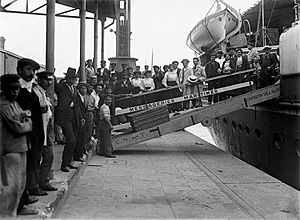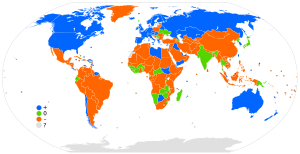Immigration facts for kids
Immigration is when people move from their home region to live in another country. These people are called immigrants. Some immigrants are refugees, meaning they had to leave their homes because of danger. Others might ask for political asylum, which is protection from their home country.
If someone wants to move to the United States, they usually apply to become a legal citizen. If accepted, they get a "green card." This card shows they are trying to stay in the country legally. They must keep this green card for at least five years before they can become a full citizen of the USA.
The words immigrant and emigrant both describe people moving. The same person is an emigrant when they leave their own country. They become an immigrant when they arrive in a new country.
Immigrants often bring new ideas and help create new things. Studies show that immigrants have started many successful companies. They are also key members in many businesses, helping to develop new products. This means immigrants can help a country's economy grow and become more creative.
Contents
What is Immigration?
The word immigration became common in the 1600s. It described people moving peacefully between different nation states. When people cross national borders to live somewhere new, they are called migrants or immigrants by the country they arrive in. From the view of the country they leave, they are called emigrants.
For example, saying "many people emigrated from Europe to America in the 1800s" means the same as "many people immigrated to America from Europe in the 1800s."
Why Do People Immigrate?
People move to new places for many different reasons. These reasons are often called push and pull factors.
Push Factors
Push factors are reasons that make people want to leave their home country. These can be things like:
- Not enough resources or jobs.
- Escape from poverty.
- Danger from persecution (being treated badly for who you are).
- Avoiding bullying, oppression, or ethnic cleansing.
- Fleeing war or natural disasters.
- Being forced into exile (kicked out of their country).
- Wanting to escape a dictatorship.
Pull Factors
Pull factors are reasons that attract people to a new country. These can include:
- A desire for better economic prosperity and more jobs.
- To find or start paid work.
- To improve their standard of living.
- Family reunification (joining family members already there).
- Moving for retirement.
- Better quality of life.
For example, in the 1800s, the United States had many jobs. This was a big "pull factor" for immigrants. They hoped to earn more money than in their home countries.
Challenges of Immigration
Moving to a new country is often very hard. When people immigrate, they leave behind their friends, family, and culture. They might also have to sell their homes or farms because these are too big to bring.
It can also be tough because of strict immigration laws. Becoming a legal citizen in a new country takes a lot of time and patience. For example, in the U.S., it can take about five years.
Learning a new language is another big challenge. Many immigrants might not have had the chance to go to school to learn the language. Not knowing the language can make everyday life very uncomfortable. Communication is needed for work, shopping, and just talking to people.
Travelling to a new country can also be very expensive. Many immigrants use all their savings to pay for fees or plane tickets.
Once immigrants arrive, they face more difficulties. They need to find a job, a house, and learn the new language. Sadly, immigrants can also experience racism or unfair treatment.
Related pages
- Migrant worker
- Human migration
- Political asylum
- Deportation
- Diaspora
- Exile
- Refugee
- Vienna Declaration
Images for kids
-
The largest Vietnamese market in Prague, also called "Little Hanoi."
-
The Iron Curtain in Europe was built to stop people from leaving Eastern Bloc countries.
-
The Indo-Bangladeshi barrier in 2007. India built this wall to stop illegal immigration.
See also
 In Spanish: Inmigración para niños
In Spanish: Inmigración para niños









